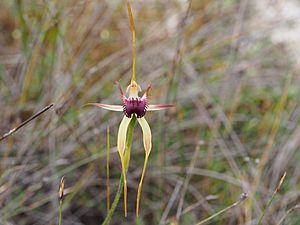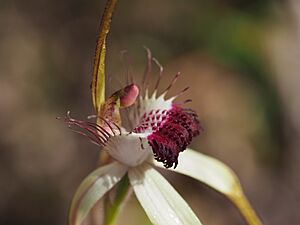Scott River spider orchid facts for kids
Quick facts for kids Scott River spider orchid |
|
|---|---|
 |
|
| Caladenia thinicola growing near Gracetown | |
| Scientific classification | |
| Genus: |
Caladenia
|
| Species: |
thinicola
|
| Synonyms | |
|
|
The Scott River spider orchid (scientific name: Caladenia thinicola) is a special type of orchid that grows only in the south-west part of Western Australia. It has a single, hairy leaf that stands up tall. Its flowers are yellowish-green and red. They have a cool fringe of long "teeth" on the sides of their labellum (which is like the orchid's lip). The tips of its sepals (part of the flower that looks like petals) are thick and brown, shaped like clubs.
Contents
What Does This Orchid Look Like?
The Scott River spider orchid is a perennial plant. This means it lives for more than two years. It's also a deciduous herb, so parts of it die back each year. It grows from an underground tuber, which is like a small storage root.
It has one leaf that stands straight up. This leaf is hairy and can be 13 to 26 centimeters (about 5 to 10 inches) long. It is about 5 to 7 millimeters (about a quarter of an inch) wide.
The plant can have up to four flowers. These flowers are yellowish-green with red marks. They are quite large, about 7 to 9 centimeters (about 3 to 3.5 inches) long and 5 to 7 centimeters (about 2 to 2.7 inches) wide. They grow on a tall stalk that can be 45 to 50 centimeters (about 1.5 to 1.6 feet) high.
Flower Parts
- Sepals: The sepals are like outer petals. They have thick, brown, club-shaped tips.
- The top sepal stands straight up. It is about 4 centimeters (1.6 inches) long and 2 millimeters wide.
- The two side sepals spread out and point downwards. They are about 4 centimeters long and 3 millimeters wide.
- Petals: The petals are about 3.5 centimeters (1.4 inches) long and 2 millimeters wide. They curve downwards.
- Labellum: This is the orchid's "lip." It is about 1.5 to 1.6 centimeters long and 1.2 to 1.3 centimeters wide. It is yellowish-green with a dark red tip that curls downwards.
- The sides of the labellum have thin, greenish "teeth" that can be up to 8 millimeters long.
- There are also four rows of dark red bumps, called calli, along the middle of the labellum. These are about 1.5 millimeters long.
This orchid usually flowers from September to November.
How Did It Get Its Name?
Scientists Stephen Hopper and Andrew Phillip Brown first officially described the Scott River spider orchid in 2001. They found a sample of it near Pemberton. Their description was published in a science journal called Nuytsia.
The scientific name, thinicola, comes from two Latin words. "Thini" means "dune," and "cola" means "dweller." So, thinicola means "dune dweller." This name makes sense because this orchid is often found growing in sand dunes.
Where Does This Orchid Live?
The Scott River spider orchid grows in a specific area of Western Australia. You can find it between Cape Naturaliste and the Warren River.
It lives in areas called the Jarrah Forest, Swan Coastal Plain, and Warren biogeographic regions. These are special areas known for their plants and animals. The orchid prefers to grow in deep sand in woodlands, especially in areas near the coast.
Is This Orchid Safe?
The Western Australian Government's Department of Parks and Wildlife has looked at the Scott River spider orchid. They have classified it as "not threatened." This means that, for now, there are enough of these orchids, and they are not in danger of disappearing.


